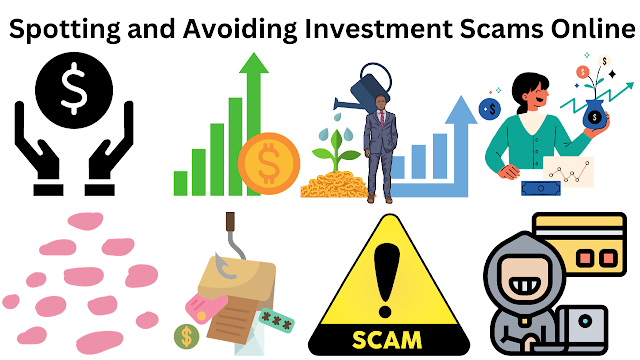Navigating the Web of Wealth: A Comprehensive Guide to Spotting and Avoiding Investment Scams Online
In the digital age, where financial transactions occur at the click of a button, the allure of online investments has captivated many. However, with this convenience comes the lurking threat of investment scams. The internet is rife with fraudulent schemes aimed at parting unsuspecting individuals from their hard-earned money. This comprehensive guide will delve into the intricacies of spotting and avoiding investment scams online, equipping you with the knowledge to navigate the digital investment landscape safely.
 |
| Spotting and Avoiding Investment Scams Online |
II. Understanding the Landscape
A. The Rise of Online Investments
The internet has democratized investing, providing access to a plethora of investment opportunities. From stocks and cryptocurrencies to crowdfunding projects, the options are vast. However, this very diversity has paved the way for scammers to exploit the unsuspecting.
B. Common Types of Investment Scams
Pyramid Schemes Pyramid schemes disguise themselves as legitimate investment opportunities but operate on a structure where returns are funded by the investments of new participants. These schemes are unsustainable and often collapse, leaving investors empty-handed.
Pump and Dump Schemes In pump and dump schemes, fraudsters artificially inflate the value of a stock by spreading positive information, only to sell their shares at the inflated price, leaving other investors with significant losses.
Cryptocurrency Scams The decentralized and relatively unregulated nature of cryptocurrencies has made them a breeding ground for scams. From fake initial coin offerings (ICOs) to fraudulent exchanges, the crypto space is fraught with risks.
III. Spotting Red Flags
A. Unrealistic Returns
One common thread among most investment scams is the promise of sky-high returns with little to no risk. Realistic returns are essential to a healthy investment, and anything that seems too good to be true likely is.
B. Lack of Regulation and Documentation
Legitimate investment opportunities are subject to regulatory oversight, and documentation is transparently available. Scams, on the other hand, often lack regulatory approval and provide vague or nonexistent documentation.
C. Pressure Tactics
Scammers frequently use high-pressure tactics to coerce individuals into making hasty decisions. Be wary of investments that require immediate action or claim that the opportunity is available for a limited time only.
IV. Conducting Due Diligence
A. Research and Verify
Before investing, conduct thorough research on the company or platform. Verify the legitimacy of the investment opportunity by checking for regulatory approvals, reviews, and testimonials from other investors.
B. Consult Financial Professionals
Seeking advice from financial professionals can provide valuable insights. Certified financial advisors can help assess the legitimacy and potential risks of an investment.
C. Use Trusted Platforms
Choose reputable and well-established platforms for investment. Verify the authenticity of websites, ensuring they use secure connections (https://) and have a track record of successful transactions.
V. Protecting Yourself: A Checklist
A. Keep Personal Information Secure
Never share sensitive information, such as passwords or social security numbers, with unknown entities. Legitimate investment platforms will never ask for such information through unsecured channels.
B. Enable Two-Factor Authentication
Add an extra layer of security to your accounts by enabling two-factor authentication. This ensures that even if your password is compromised, an additional verification step is required for access.
C. Monitor Accounts Regularly
Frequently monitor your investment accounts for any suspicious activity. Promptly report any unauthorized transactions to the platform and your financial institution.
VI. Conclusion
In the ever-evolving digital landscape, the potential for investment scams remains a constant threat. By understanding the red flags, conducting due diligence, and implementing protective measures, you can safeguard your financial interests. Remember, a well-informed investor is the best defense against online investment scams. Stay vigilant, stay informed, and navigate the web of wealth with confidence.